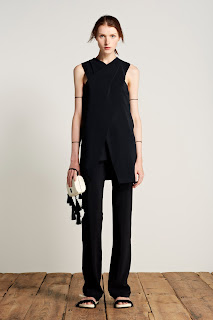When I got it home, it became apparent that the tone of the rayon's greyness was a tad too warm for the grey of the fashion fabric; more beigey than grey, in fact. Lesson: always take a swatch of your fabric when shopping for matching fabric. Head shake at self here....
You'd be completely justified to roll your eyes in my general general direction, and say: get over yourself, woman! for pity's sake, who looks at lining?!
Well.... I do. Every time I put the garment on, and then every time I take it off. And we sew for ourselves, right?
You already see what's coming here: another dye job, right? Right! But this one, with a difference: rather than just plain stove top immersion dyeing, I decided to try for a pattern. I've long been reading about shibori techniques, but have not yet dared to try any. I've never done anything patterned before, in fact. This seemed like the perfect opportunity to attempt a never-before-tried experiment: whatever the aesthetic effect, the lining will be wearable, since it'll be quite invisible to the world at large. Indeed, a very safe experiment.
To connect with the pattern of the fashion fabric, I decided on a rectangularish-squarish-patterned tie dye. I concertina-pleated the lining and then tightly tied narrow bands across the pleats. Both the pleat widths and the tie intervals are about 6", or 15 cm.
I then soaked the tied fabric in a warm solution of soda ash and salt - this improves the dye molecules bonding with the fabric. Squeezing out the solution, I placed my wet, tied fabric roll on an inverted aluminum cookie sheet in the sink, and squirted dye over it from a squeeze bottle.
I used two dyes: Rit liquid dye in navy as the main player, and black instant set Colorhue dye as a finishing touch.
After applying the dyes to my fabric roll, I placed it in a glass bowl, wrapped the lot with thick plastic, microwaved for a total of three minutes, waited for it all to cool, rinsed in the sink, then machine washed in cold water with plenty of soap.
I had no idea what to expect. But I hoped that the navy dye will at the very least cool down the beigey tone of the lining's original colour, and thus bring it a little closer to my conception of how the colour of the lining ought to play with the grey of the pendleton. And I knew that the result will be rather subtle, being dark navy on top of mid-tone beige. I like subtle.
The result? I'm delighted! Tickled! Amazed! I got an unexpected, regular yet very organic pattern, with colours that are mainly cool purplish blue on top of the beige. It also appears that the Colourhue dye reacted with the aluminum pan and gave some greenish-tealish tones to the final result. The edges of the pleats absorbed more of the dye and created dark horizontal lines, while the ties across the pleats (which prevented the dye from reaching in) created soft light coloured vertical lines.
I'll be very happy to have this unusual wacky lining inside my very regularly patterned coat!
It's so easy to say to oneself, I wish I could, but I don't know how, I've never done it, therefore I can't.
And that's why the last word today belongs to Gary Trudeau:
Amazingly, I remember reading and loving this strip when it was first published:
21st February 1974.
Even then, its message resonated with me: dare to try.
Dare to aim higher!
Dare to be bold!
Just do it.


















































